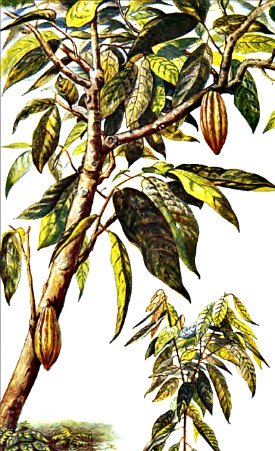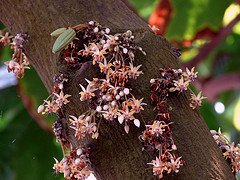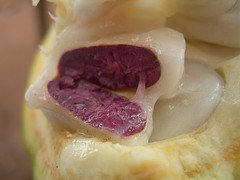Chocolate Tree: Wild Wonder of the Amazon
Use this search box to find the info you're looking for!


Call it the chocolate tree, cacao tree, or cocoa tree. Just don't call it ordinary.
Strange and difficult to raise, it's been cultivated for centuries.
This freakish bit of flora is as demanding and inflexible as the god's themselves.
Forced onto the plantation, it refuses to thrive, growing by it's own rules.
Weird and wonderful, we'd better coddle it.
It's the only source of chocolate.
Face it, this bizarre tree has us hooked and at it's mercy!
Scientific Name, Mayan Names and Common Names
Our favorite tree has many names.
Theobroma cacao is the scientific name given to the tree by Linnaeus, a Swedish naturalist, in 1753.
The name means "food of the gods." It's a little taste of Heaven on Earth.
Two ancient Maya names for the tree are...
- Madre Cacao-Mother Cacao-Source: authenticmaya.com
- Cacahuaquchtl-Source: The Bittersweet World of Chocolate
Common names are chocolate tree, cacao tree, or cocoa tree.
The Cocoa Tree
Theobroma cacao is a tropical evergreen.
- It's an understory tree, growing beneath the taller trees that form the canopy.
- The average wild tree grows to about 40 ft.
- Plantation grown trees are pruned to grow only 20 ft tall for ease of harvest.
- The leaves are poisonous. Source: Wikipedia
- The bark is thick and dark gray-brown in color.
- Mosses, lichens, and orchids cling to it's bark. Source: Salute To Chocolate
Depending on the variety, a cocoa tree can produce pods as early as two years or as late as four. Source:THE NEW TASTE of CHOCOLATE
Under good conditions, a single mature cacao tree produces an average of thirty to forty pods in a year. Source: www.amnh.org
Duration of “peak growing period” for the average cocoa tree: 10 years. Source: World Cocoa Foundation
Where Do Cacao Trees Grow?
Only where they want to!
Cocoa trees can only grow within 10 degrees north or 10 degrees south of the equator. The moist, shady, tropical rain forest region is home.
They evolved in the Amazon region. But today chocolate trees grow around the world between the tropic of Cancer and the tropic of Capricorn.
Wouldn't you love to have one of these in your backyard? Me, too. Thought about it, but I live in the semi-tropic sun.
Not quite good enough...yet. But there could be an up-side to this global warming thing!
Cocoa Growing
Our favorite tree is difficult to grow. It's fragile and prone to disease.
So intimately tied to it's natural habitat, it performs poorly in the unnatural plantation setting.
Our finicky friend requires...
- protection from the wind when young
- shade as a seedling
- lots of rain-80 inches a year
- soil must both retain water and be well drained
- a minimum temperature of 65 degrees
- high humidity
Older trees do best in light shade but they can grow in any light.
Farmers frequently grow cacao in full sun. This results in...
- a temporary increase in production
- a possible reduction in productive years
- greater susceptibility to disease
Shade-grown cocoa trees can produce fruit for 75 to 100 years or more. Source: CMA:The Cocoa Tree.
On-going research by Allen Young, has shown that the more closely the growing environment resembles old-growth forest, the healthier the cacao trees. Source: www.amnh.org
Looks like it's back to the rain forest. It's more efficient to grow our favorite tree in small patches in the shade.
Chocolate Flowers
Photo courtesy of Tatters:)

The chocolate tree is certainly strange. Flowers and seed pods grow on the trunk and the older branches.
Normal fruit trees produce flowers on the tips of the branches.
It looks bizarre, like someone hung the flowers and pods on the tree. Resembles some sort of weird Christmas tree.
The tree blossoms all year long.
- Blossoms can be white, yellow, pink, or even two colors at once. Source: Salute To Chocolate
- The cacao flower is about the diameter of a nickel. The midge is the only animal that can work its way through the complicated flower. Source: www.amnh.org.
- A chocolate tree produces hundreds of flowers a year.
- typically 1 to 3 percent of those flowers are fertilized and produce seed pods. Source: www. amnh.org.
Why do so few flowers produce pods? Seems that all-important midge doesn't thrive on the plantation either.
It needs the tree litter and rotting pods of the forest.
Cocoa Pod
The pods are as bizarre as the strange and wonderful chocolate tree.
- Pods are from 6 to 12 inches in length.
- Some are shaped like a football, or an elongated football. Other pods are melon shaped.
- Most pods have ridges or crinkles but some are smooth.
- Pods can take six months to reach maturity.
- The color of mature pods can vary widely from purple, green, red, or yellow. It takes an experienced eye to determine when they're ripe.
- Cocoa pods never fall from the tree.
- They're harvested by humans or removed by animals.
- Cocoa seeds are scattered by small animals who gnaw through the pod to eat the sweet pulp. They avoid the bitter seeds.
- The seeds are the source of chocolate.

Photo courtesy of Lall
The contents of the pod are less than appetizing to behold. The dark seeds are buried in a white slimy mush.
The mush is alleged to be tasty. I'll take their word for it.
The interior looks like it was designed to carry alien life across the cosmos. You feel like something might burst forth at any moment. I
It was a brave or desperate person who first ate that stuff.
Pods are harvested throughout the year. But there are normally two main harvests per year.
Almost 70% of the world crop is grown in West Africa. Source: http://en.wikipedia.org/wiki/
Cocoa
Cacao Diseases
Sadly, our favorite tree is susceptible to disease. Nature, it seems, doesn't want us to have an overabundance of our favorite food.
Tragically, almost one-third of world-production is lost to disease. Source: UNCTAD website
Some of the most common diseases are...
- witches' broom-a fungal disease that causes the tree to sprout lots of new leaves. Later they wither and die looking like a broom.
- black pod rot-is a fungal disease that causes small, dark, hard spots on the pod. The pod shrivels and mummifies.
Some common pests are...
- mirids-they puncture pods, stems and branches producing ugly lethal spots. They can also cause dieback.
- cocoa pod borer, also know as the cocoa moth, can cause premature ripening of the pod. This damages the quality and quantity of the beans.
Source: icco.org
3 Major Varieties of Cocoa Trees
There are three varieties of the chocolate tree...
- Criollo are considered to produce the best tasting beans. They once dominated the market but pure trees are rare today. Expensive.
- Forastero produce bulk beans, not as tasty as the other two. But more prolific, they make up 90% of the cocoa beans we love.
- Trinitario are a cross between the other two trees. They produce flavor beans also. They account for less than 5% of the world production of cocoa beans.
Cocoa Tree Breakthrough!
Fantastic news for the cocoa tree and you, chocolate lover! The basic genome of our favorite tree has been mapped.
Thanks to researchers from the USDA, IBM and Mars Candy company the future of the chocolate tree is a whole lot brighter.
Soon science will sort out the best genes and improve the crop.
That should mean a stable supply of cocoa. But even more may be possible, such as improved taste, and perhaps an increase in antioxidant levels.
Sounds like our dream is about to become reality. More and maybe even better tasting dark chocolate! Health benefits heaven on Earth!
Maybe a chocolate tree in every yard? Am I asking for too much? I don't think so, but I could be wrong.
Cocoa Tree Expeditions
In 2008 and 2009, exploration of Peru's Amazon Basin turned up some new varieties of cocoa. Plus a very old and scarce one, Pure Nacional, loved for its superior flavor.
Researchers hope studying these new cocoa trees will help in the fight against diseases that plague our favorite tree. And maybe even produce new flavors.
Let's hope more trips are planned to save our wild cocoa. Be a real shame to miss out on any fantastic flavors waiting to be discovered!
Humans have tried to break it's wild spirit. But this native of the deep, dark, dank,
jungle refuses to thrive under our rules. It's only fair that we give the chocolate tree
what it wants so it returns the favor. Do we have a choice?
Want to color your own cocoa tree or cocoa pod?
Return to Chocolate Facts
Return to Health Benefits of Dark Chocolate Home Page
New! Comments
Feeling the need to send some feedback? Leave me a comment in the box below.